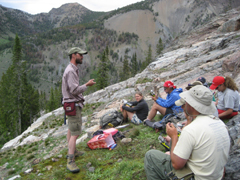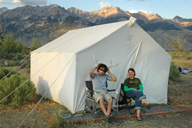ISU field camp explores Idaho’s geology in wild settings
August 2, 2007
Students from throughout the United States – not to mention an international student from Serbia – attending the Idaho State University geology camp experienced quintessential wild Idaho while participating in the ISU geosciences department’s “capstone course” this summer.
The camp, specializing in geological mapping, is based at the Lost River Field Station at an elevation of 6,400 feet in the shadow of Idaho’s tallest peak, 12,662-foot Mt. Borah. During a summer visit here, some 20 miles north of the small town of Mackay in central Idaho, it is common to see the Idaho state bird, the Mountain Bluebird, flit around and land on the station’s picnic tables, buildings and vehicles.
 The scenery is spectacular, the setting is wild and the facilities are comfortable. But more importantly for geology students, in all directions from the camp there are extraordinary geological features in terms of their diversity and study value. During the five-week class in June and July, most field trips are daylong journeys located within 50 miles of the camp or much closer. Field camp director Paul Link, PhD, notes that with the exceptions of the Yellowstone National Park and Craters of the Moon National Monument and Preserve field trips, activities take place in remote areas.
The scenery is spectacular, the setting is wild and the facilities are comfortable. But more importantly for geology students, in all directions from the camp there are extraordinary geological features in terms of their diversity and study value. During the five-week class in June and July, most field trips are daylong journeys located within 50 miles of the camp or much closer. Field camp director Paul Link, PhD, notes that with the exceptions of the Yellowstone National Park and Craters of the Moon National Monument and Preserve field trips, activities take place in remote areas.
“At most of the places we go, we never see anybody,” Link said. “We might see somebody along the road when we’re driving, but where we hike it is generally just us.”
“This is the perfect laboratory,” said Josh Keeley, a senior at the University of Rhode Island. “The diversity of the geological formations is just a lot more than what you find along the East Coast.”
“If you know anything about geology, you have everything here,” said Kevin Pelletier, a senior from the University of Maine. “There is sedimentary rock, granite, metamorphic rock surrounded by granite and you can study sedimentary tectonics, volcanic geology, active faults and other geological formations. It is all here. You can’t beat it.”
The camp features a rigorous academic curriculum. Students are given days off and have time for a host of leisurely activities, but most days are marked by a full day in the field, followed by work in the lab.
<> “The bottom line,” Keeley said, “is that when I leave here I will be a field geologist and know how to map about any kind of terrain there is.”Working long hours in the field coupled with an intense academic environment pays off for the students.
“The most important thing for me is how much I’ve been able to finally understand how to map,” said Lindy Straathof of Central Michigan University. “Coming here has really helped me improve my confidence as a geologist.”
Besides being academically challenging, the camp is also physically demanding. This isn’t a camp where participants drive from one geological formation to the next in an air-conditioned car and then spend the night in a motel with cable TV. Students and their mentors climb up steep mountains and walk through a variety of terrain.
“I was in the military for nearly 10 years (as a Green Beret) so this type of activity is not new to me,” Pelletier said. “This camp is a good time, but it is very physically challenging, even coming from my background. This is not a highway field camp like some. Here, you are actually in the middle of nowhere a lot of the time and it feels like a field camp.”
Valentina Taranovic, a Serbian international student from Wayne State University in Detroit, noted the elevation difference between Detroit at 500 feet and the elevations of the geology camp activities.
“I’ve had a pretty hard time adjusting,” Taranovic said. “We’ve gone above 10,000 feet. Besides the fact I can’t breathe, everything else is fine.”
The camp is popular with its students and sometimes serves to recruit students into ISU’s geosciences graduate program.
“I enjoyed every part of it,” noted one student in an evaluation this year. “The profs were all great and very informative and inspirational. The projects were ideal for a capstone undergrad geology course and provided more education than expected. A very positive experience.”
Facilities at the camp are a mix of the rustic and modern. Students sleep in large canvas “outfitter” tents or tepees on cots, located near the banks of the willow and cotton tree-lined banks of the Big Lost River. The field station features a large building with kitchen facilities, study area and a loft featuring Internet connections and phone lines. There are showers, laundry facilities and a hot tub available. For recreation, there is a horseshoe pit, ping-pong table and dartboard.
“We have a first-rate cook, Cathy Loupy. She’s the best cook in Custer and Butte counties combined,” Link said. “We receive a lot of compliments on the camp food.”
For more information on the field camp or the ISU geosciences department, call (208) 282-3395 or visit http://geology.isu.edu/FieldCamp/.
Categories:
